Recent Storm Damage Posts
3 Essential Flood Safety Tips
8/26/2022 (Permalink)
 Keep an emergency kit in your home
Keep an emergency kit in your home
Ways To Prepare For The Event Of a Flood
If your home in West Glenn Estates, AZ, is prone to flooding, it is important to be prepared in case of an emergency. Knowing proper flood safety can be pivotal to keeping yourself and your family safe, especially since events such as flash floods can come quickly and without warning. Use these three essential safety tips to help you prepare for the event of a flood.
Keep an Emergency Kit In Your Home
An emergency kit is a good idea to have around the home at any given time in case of a flood, as these events can quickly turn into an emergency. In your kit, you should keep a flashlight with extra batteries in case of a power outage. In addition, a radio may be helpful to keep track of the weather and any emergency services. Keeping a portable phone charger may also be a good idea. Non-perishable, canned foods and bottled water should also be included in any emergency kit.
Stay Away From Flood Waters
Flood safety also means staying away from floodwaters as much as possible. Driving especially can be dangerous and quickly become deadly. If your home begins to flood or is at risk to begin to flood, try, and stay on the upper floor to avoid these waters, as they can be dangerous or contaminated.
Know When to Relocate
It's important to understand when you need to relocate during a flood. If local officials recommend relocation or evacuation, it's important to do so promptly to avoid dangerous flooding. If you choose to relocate during a flood, be sure to do so as soon as possible, as roads can very quickly become dangerous to drive in.
Flood safety is an important part of staying prepared during national disasters. Floods can quickly become overwhelming and dangerous, so be sure to stay prepared and keep up with local officials recommendations. In the event of a damaging flood, contacting an emergency restoration company as soon as it's safe to do so will help you restore your home.
3 Steps to Take After a Black Water Flood
7/8/2022 (Permalink)
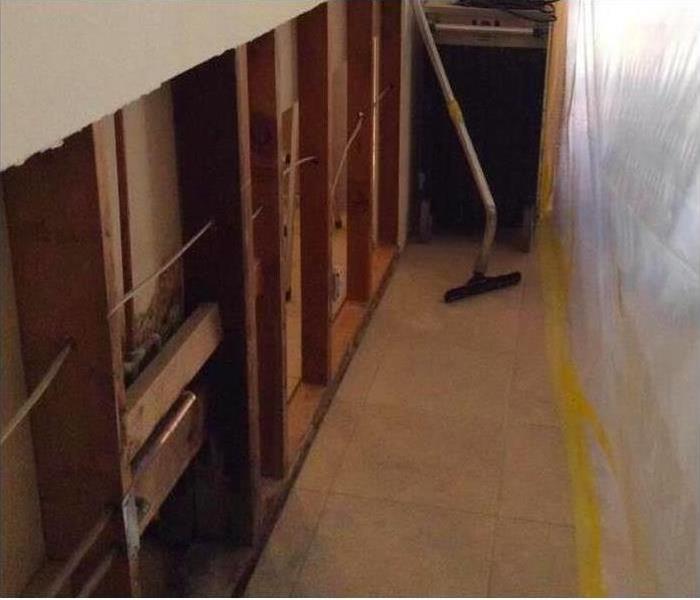 Water cleanup services after severe damage in Glendale, AZ.
Water cleanup services after severe damage in Glendale, AZ.
Three Steps To Take After A Black Water Flood
Commercial property owners in Glendale, AZ, know the devastating effects of water damage to their buildings. The source of the water that floods a building could leave its natural construction materials irreparable, especially if it is black water or highly contaminated water. Some common causes of floods in buildings include:
- Toilet overflow
- Inclement weather
- Sewage backup
1. Clean the Water
The first step is to get rid of as much water as you can. If the water you are handling is black water, use protective gear, such as gloves and a mask, to prevent infections and illness. Sop up the flood with old rags, towels, and a water vacuum if one is available to you.
2. Dehumidify Your Property
The natural construction material used to build your property, such as wood and drywall, will remain humid after a flood. This causes severe damage if you do not treat it, leaving room for microbial growth and rotting. To dehumidify materials, you can run a dehumidifier in the room until the moisture has left most of the porous items in the room. There are services available to dehumidify property if you would rather leave the job to a professional.
3. Restore Property
To complete the process, restore any materials that have been left irreparable. If the job is too severe for a single person, contact a professional water damage restoration service to aid in restoring your property to normal. Insurance companies often cover damage expenses from plumbing leaks. Check with your insurance provider before attempting to fix damages yourself.
Water damage can be costly and causes property owners a headache. Know these steps to get ahead after experiencing heavy damage to your building. Acting quickly in an emergency plumbing situation can prevent severe damages from leaving the natural construction materials of a property irreparable.
3 Tips for Reduction of Odors From Water Damage
7/1/2022 (Permalink)
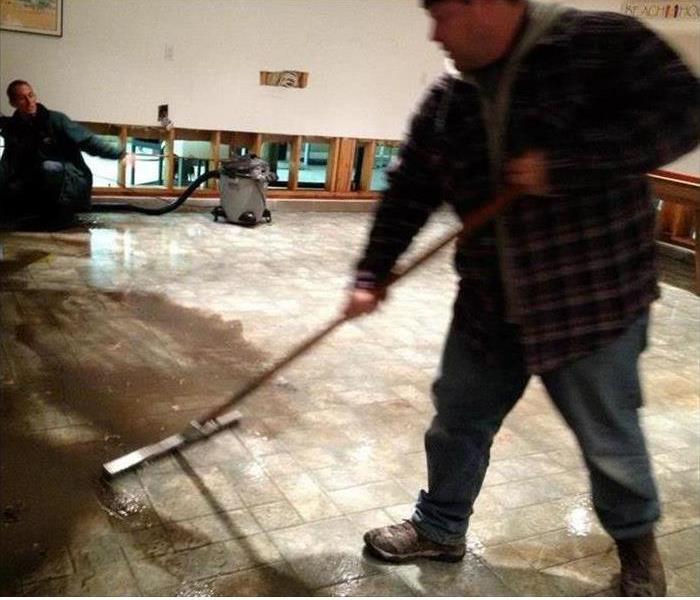 While floods often lead to less than pleasant odors due to factors like mold growth and bacteria, the smells can be removed or at least mitigated.
While floods often lead to less than pleasant odors due to factors like mold growth and bacteria, the smells can be removed or at least mitigated.
3 Ways To Reduce Odors Caused By Water Damage
Even after you or a professional cleanup and restoration service from Weedville, AZ, has removed any standing flood water from your building, there might be disagreeable smells. They may be the result of sewage loss from pipes or the street, mold growth from leftover moisture or bacteria carried in by gray water or black water. There are some actions that can help reduce or eliminate the unpleasant odors that arise from water damage.
1. Make Sure Everything Is Actually Dry
Any excess moisture can serve as a breeding ground for mold growth and mildew. The microorganisms emit musty scents akin to dirty socks or dirt as they progress through different stages of development. It can also harbor stink-producing bacteria. It is important to remove as much water as possible by opening windows, wringing out or trashing soaked textiles, drying off surfaces, and using fans and dehumidifiers.
2. Use Common Remedies
If the smell clings to a room, there are certain substances you can place in open containers around it to try and absorb the odor from the air, including:
- Cat litter
- Vinegar
- Baking soda
These are available for purchase at many generic stores or shopping centers and have deodorizing capabilities. Baking soda can also be sprinkled on carpet, rugs or fabric-covered office furniture and vacuumed up to remove both liquid and nasty fragrances.
3. Disinfect Affected Surfaces
Sanitizing anything the water has touched can help ward off or kill mold in its beginning stages. Even if there is none visible, it might already have begun to release spores and infect porous materials. While bleach may seem like the obvious choice of cleanser, it generally only affects surface mold, not the filamentous roots or spores. A vinegar and warm water solution or soap and warm water mixture will prove more effective at removing the fungus.
While floods often lead to less than pleasant odors due to factors like mold growth and bacteria, the smells can be completely removed or at least mitigated. There are also professionals trained at disaster cleanup you can contact.
Sump Pump Maintenance Tips
6/6/2022 (Permalink)
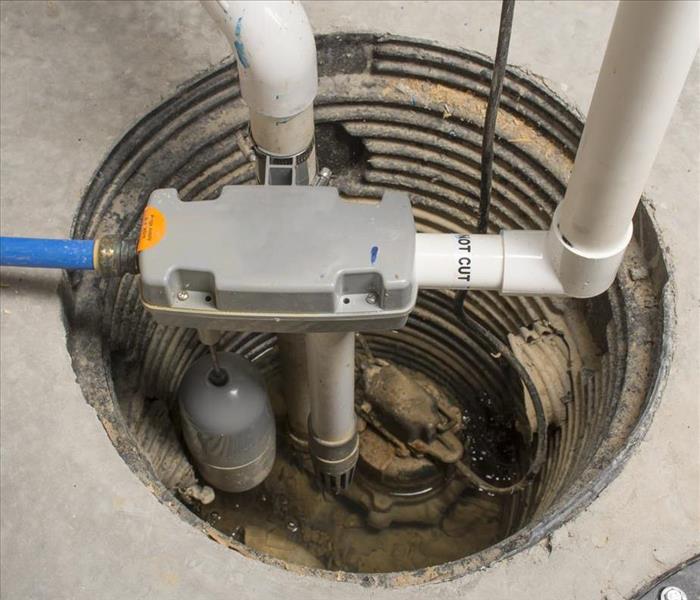 A sump pump is a vital piece of equipment that keeps floodwaters from rising in your Glendale, AZ, home.
A sump pump is a vital piece of equipment that keeps floodwaters from rising in your Glendale, AZ, home.
Maintenance Suggestions for Sump Pumps
If your home in Glendale, AZ, has a sump pump, you get the added peace of mind that unwanted water will be deterred from entering your home.
Unfortunately, this vital component is easy to forget about. Instead of having to call a mold and water damage professional to restore the basement after the next heavy rain, take some preventive measures to ensure your equipment is working correctly.
Pump Maintenance Tips
Like with many things in life, maintenance is key to the equipment being reliable and working properly. Below are some maintenance tips to help keep your sump pump running.
Every quarter, empty any water out of the basin and remove any buildup. Clean the inlet screen to ensure it is clear.
The pump should be tested annually. It is recommended to do it before the rainy season sets in.
After testing the pump, clean it thoroughly and inspect it for any parts that look worn or damaged.
If it doesn’t have a battery backup, install one. If a power outage occurs, this will ensure the pump keeps running.
While it’s good to understand the basics of how your equipment works, it may be worth having a certified plumber do the annual inspection.
Signs of Trouble
Although regular maintenance helps this type of equipment last longer, there could be lurking issues that rear their ugly heads. Signs it might be time for an upgrade or repair include:
- Moldy, rotten odors are emanating from the basement.
- The pump shows signs of rusting.
- Banging or humming sounds are heard while it is in operation.
- The basement has water in it.
- The unit is between seven and 10 years old.
A sump pump is a vital piece of equipment that keeps floodwaters from rising in your home. Conducting regular maintenance and checking it while it is in operation is key to it being reliable.
During Which Stage of Flood Cleanup Can Employees Reenter the Building?
5/1/2022 (Permalink)
 The final phase of flood cleanup requires teams to rebuild structural integrity. Call SERVPRO for further information.
The final phase of flood cleanup requires teams to rebuild structural integrity. Call SERVPRO for further information.
Employees Can Reenter The Building During Which Stage Of Flood Cleanup?
Water Category 3 or Contaminated water houses excessively high levels of pathogens. The premises may have become impacted with feces, urine, mold and organisms, all of which may seep into the structure. Because of the exposure, it's not appropriate for staff to immediately reenter the impacted spaces unless they are part of the cleanup crew. A water restoration company in Peoria, AZ, understands how to protect themselves and others as well as minimize the spread of the contamination.
1. Phase 1: Tear Out
The first stage of flood cleanup focuses on mitigating trouble. The experts enter to premises and remove structural materials contaminated with moisture. The impacted zones demand prompt and meticulous examination to avoid further spread and harm. Should staff walk in and out, they could be exposed to the pathogens and carry them to other establishment areas.
The crew should section off this area, creating physical barriers. They also use negative air chambers to reduce air exposure. Porous materials such as drywall and carpet harbor the organisms as the water penetrates deep within the pieces. Not even a good bleaching would guarantee thorough cleaning.
2. Phase 2: Sanitization
Contaminated water still lingers on nonporous objects, so content cleaning and sanitizing must occur. The interior is scrubbed thoroughly with water and soap. Also, technicians apply an antimicrobial spray, killing off surface microbes.
The team uses high-tech procedures to salvage electronics, documents and photos.
3. Phase 3: Restoration
The final phase of flood cleanup requires teams to rebuild the structural integrity. At this time, air filtration devices continue to run, but the room is clear of germs. Employees may return. They should be cognizant of the workers' efforts to put everything back in place.
Contaminated water isn't something to work around. Because of its high level of sewage and bacteria, it's best to keep employees out. This decision assists in preventing further issues.
Preparing Your Business for Severe Thunderstorms
1/13/2022 (Permalink)
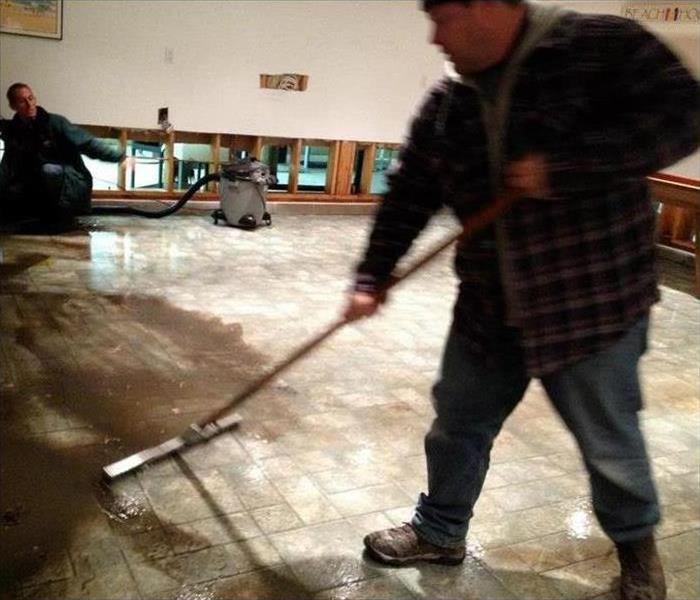 Our SERVPRO team is available 24 hours a day, 7 days a week, for any essential storm damage cleanup and restoration in your business.
Our SERVPRO team is available 24 hours a day, 7 days a week, for any essential storm damage cleanup and restoration in your business.
Getting Ready For Severe Thunderstorms In Your Business
A rain storm is different from a severe thunderstorm in several ways: thunder, lightning and strong winds. It is advised to find shelter and stay indoors when severe weather strikes, but what else should a business be doing to protect its assets, employees and customers.
1. Keep Trees and Shrubs Trimmed
The exterior of your building can become extremely dangerous during high winds and severe weather, especially with unkempt trees and shrubs. While many plants and trees appear fine in normal weather conditions, long branches or otherwise innocuous bare limbs can become projectiles in certain instances. It is best to keep trees and shrubs trimmed to prevent any possible issues.
2. Have an Emergency Plan
A rain storm is mild enough to continue with your day-to-day operations, but a severe storm changes things. With lightning and strong wind gusts, it is best to stay indoors and preferably away from windows and doors. As a business owner, it is best to create an emergency plan for all employees. You should find a designated storm shelter within the building away from the exterior.
3. Know First Aid
In an emergency situation, it pays to have knowledgeable people present. For instance, it is wise to have employees who are aware of basic first aid practices, including CPR. This way, you ensure that there are people present who can safely apply aid while waiting for rescue if it comes to that.
4. Install Lightning Rods and Other Defensive Measures
Beyond planning and first aid, you can install lightning rods and generators to prevent damage to electrical systems. A disaster restoration specialist in the Glendale, AZ area can help you come up with a specific plan for your business and building.
While a rain storm may not cause the greatest concern, a severe thunderstorm should not be taken lightly. These storms can wreak havoc on electrical systems and may even cause physical harm to you or your employees. Know your options and plan ahead.
The Basics of Business Interruption Insurance
11/1/2021 (Permalink)
 If your business has been damaged by flood, SERVPRO is here, always ready to help you. Call us!
If your business has been damaged by flood, SERVPRO is here, always ready to help you. Call us!
Business Interruption Insurance Fundamentals
Many business owners in Glendale, AZ, have disaster insurance, commercial building insurance and even personal property insurance, but not many consider business interruption insurance. Interruption coverage can be as crucial as a flood or disaster policy, and perhaps even more so. Whereas most insurance policies cover physical damages, they do not cover intangible losses, such as lost revenue and lost customers, that are the result of a closed business or a necessary rebuild. If you don’t have interruption coverage for your business, here are a few good reasons you should consider purchasing a policy today:
- It covers lost income that results when you are forced to leave the premises for an extended period.
- It covers the revenue you would have earned based on earning reports from previous years.
- It covers operating costs that may or may not continue post-disaster, such as electricity.
Cover Your Bases With a Sound Policy
Unfortunately, there is no telling how long you will be out of business post-disaster. If your building was subject to a flood, you may only be closed for the week that it takes the water remediation team to clean out your structure and its contents. However, if your Glendale, AZ, building was in the path of a tornado or a hurricane, you may have to rebuild entirely, which could take months.
Even a week of lost income can be financially damaging; months of lost revenue can mean the end of your business. Bearing that in mind, you should consider investing in a policy that covers your company for more than a few days. Most business interruption policies allow the insured to cover losses for a period of restoration up to 720 days.
Don’t Let a Disaster Close Your Doors — Get the Coverage You Need
If you live in a disaster-prone area, the smartest thing you can do for your business and your livelihood is to invest in interruption coverage. The right policy can cover losses during the entire time it takes to rebuild and reopen your doors.
4 Steps To Deal With Flood Mold
10/22/2021 (Permalink)
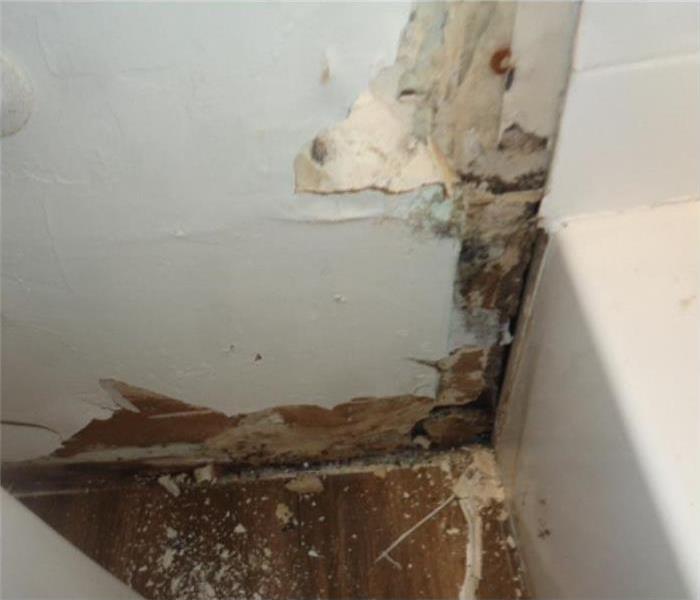 When water leads to mold growth.
When water leads to mold growth.
4 Steps to Resolve Flood Mold
Whether it’s from a storm or a broken pipe, flooding can be stressful to deal with. Mold growth is one of the most common side effects of a flood. If you’re struggling with the problems of overflowing water and the resultant mildew, here is how you can deal with it.
1. Disconnect Power
As soon as you notice that there’s standing water in your Peoria, AZ home, it’s important to turn off all of the power. Even if the water isn’t close to an electrical outlet, this is a safety precaution that you don’t want to ignore. If for any reason the water travels, you don’t want to run the risk of electric shock.
2. Drain Water
The next step is to call for an extraction specialist to get rid of the water. Since standing water can lead to bacteria and mold growth and can be dangerous to remove, you need someone who has experience dealing with flooding. Additionally, you want to guarantee that all of the moisture has been removed. Professional companies can provide experts with the right gear for the job.
3. Disinfect
You should not hesitate before taking any of these steps. Keep in mind that mold growth can occur in as little as 24 hours. Disinfecting your belongings and home should come once the building is dried out. Use vinegar, water and detergent to clean walls and furniture of mold.
4. Prevention
The best way to prevent mold growth is to not allow standing water to remain in your home for long. Mold growth thrives in warm, moist environments. Utilizing air flow and keeping everything dry can help you avoid dealing with mold in the future.
Floods can be devastating, and the mold growth that comes from a flood can be difficult to clean up. Fortunately, remembering these steps can help you handle the problems that occur once you’ve discovered the standing water.
Never Be up That Creek Without a Paddle: What Causes Sewage Backups in the Basement?
8/30/2021 (Permalink)
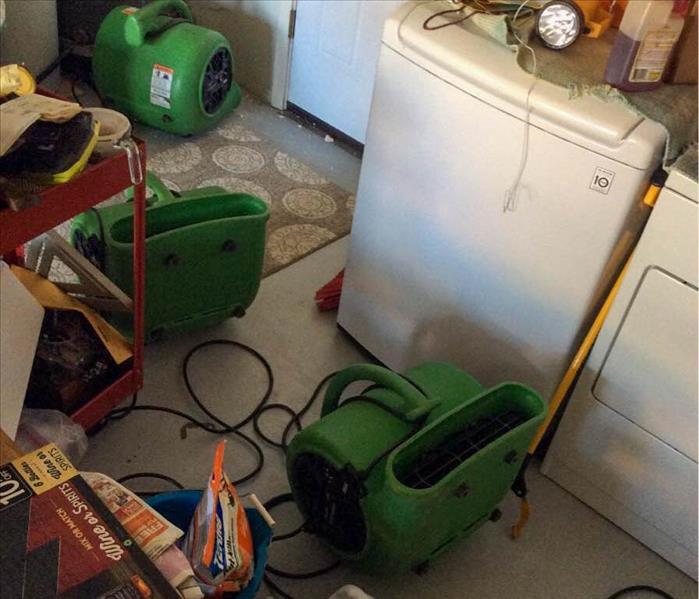 A flooded basement is never fun but being aware of the causes can help you plan preventative steps to limit the likelihood that it'll happen again.
A flooded basement is never fun but being aware of the causes can help you plan preventative steps to limit the likelihood that it'll happen again.
A flooded basement can be a nightmare, but when you add the concern for contamination and possible infection from sewage that nightmare reaches new cataclysmic heights. There are several causes of sewage backups, and, while many of them are preventable with routine maintenance, the top four are as follows:
1. Roots Obstructing the Line
Trees and shrubs are the leading cause of blockages in sewer lines because, as they seek moisture, the roots invade the pipes through compromised areas. It is this buildup of roots as well as the breakdown of older clay pipes that combine to create blockages, which leads to flooding and backups.
2. Improperly Flushed Items
A flooded basement can also be the result of improperly disposed of or flushed items. Grease, like cooking oil, and paper products, like paper towels, diapers, and feminine products, form blockages in waste lines, preventing the free flow of water and causing it to back up into the nearest open drain.
3. Intentional Vandalism
For world travelers, or anyone with a toddler, vandalism, whether intentional or not, can lead to floods and sewer issues. Rebellious teens or vagrants may find a way of crashing a vacant house and purposely cause damage by clogging the drains. Your toddler, on the other hand, may only be curious to see if his/her binky can survive a good flushing
4. Municipal Sanitary Main
While there are many preventative steps you can take against possible floodings, like updating your old clay pipes to prevent root infestation, properly disposing of items, or updating security, some things aren’t under your control. The city sewer main is one of those things. While this is rare, storms, flash floods, or mechanical errors can cause disruptions of the free flow of water, resulting in your floor drains backing up.
A flooded basement is never fun but being aware of the causes can help you plan preventative steps to limit the likelihood that you’ll ever have to experience such a disaster. However, despite the best planning, if you experience flooding in the Glendale, AZ, area there are several restoration specialists who can help you figure out your next steps.
How Winter Storms Can Lead to Frozen Pipes in Your Building
5/14/2021 (Permalink)
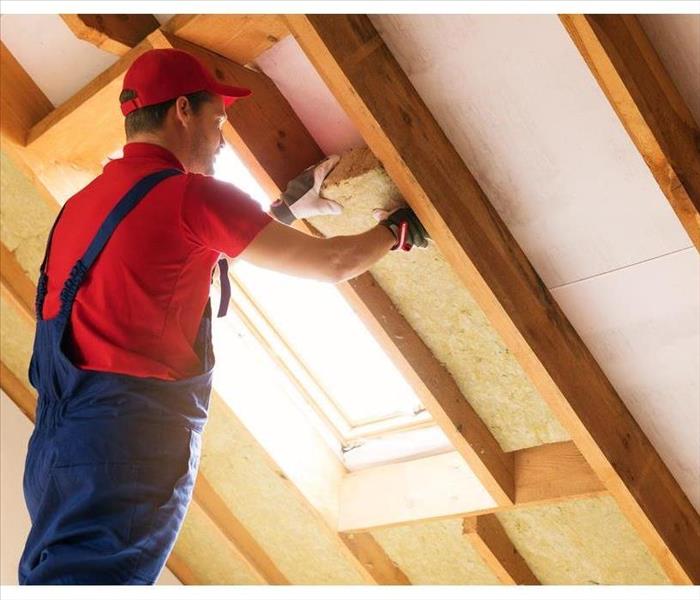 Add insulation to cold areas of the building.
Add insulation to cold areas of the building.
Why Do Pipes Freeze In The Winter
Rain storms are not the only type of severe weather that can damage your Peoria, AZ, property. Snow storms, and the cold temperatures that accompany them, can be just as harmful. Specifically, winter storms can cause pipes to freeze and then break. This can lead to a buildup of standing water.
As the temperature drops, water expands and turns into ice. This puts extra pressure on the pipes holding the water. If the condition persists, you could end up with at least one burst pipe. While this problem can occur anywhere, it is most common in:
- Pipes that run against poorly insulated walls
- Outdoor pipes such as sprinkler lines
- Pipes that supply water to unheated areas such as cabinets and basements
Thawing Frozen Pipes
If you notice minimal water trickling out of an open faucet, you likely have a frozen pipe in your building. You need to thaw this pipe immediately before it bursts and necessitates flood cleanup services.
Keep the faucet open as you do this. The flowing water should melt any remaining ice, further reducing your chances of a burst pipe.
First, you have to locate the pipe that has frozen. Check in the coldest areas of the building first. Once you find the pipe, use a space heater, a hot towel, a hair dryer or a heating pad to warm the pipe.
Preventing Frozen Pipes
Ideally, you should stop pipes on your property from freezing at all. The best way to do this is to add insulation to basements and other cold areas of the building. You should also keep any bathroom and kitchen cabinets open so warmer air can circulate near the pipes in those locations.
Floods do not only occur during rain storms. Cold winter storms can cause a burst pipe to spray water all over your building. You thus need to keep your pipes as warm as possible and thaw any frozen ones immediately.
How to Prevent Mold Growth After a Flood
11/13/2020 (Permalink)
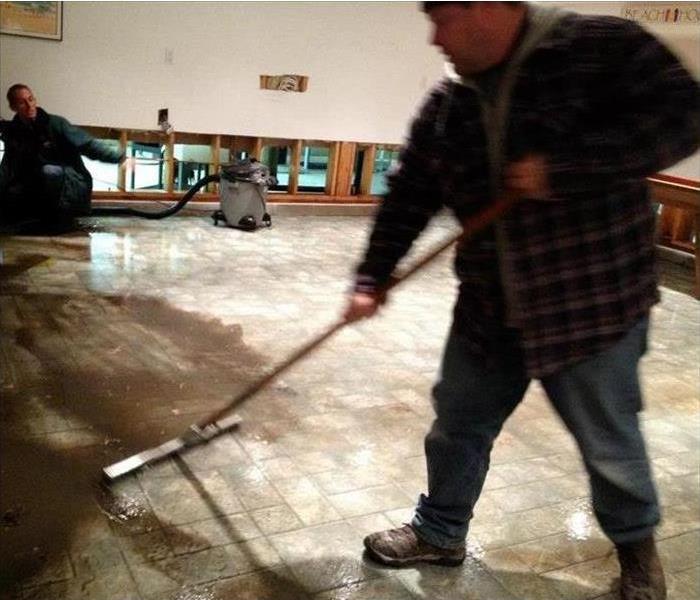 The aftermath of a storm in West Glenn Estates, AZ
The aftermath of a storm in West Glenn Estates, AZ
Damage caused by severe storms and flooding is bad enough on its own, but it's not the only issue that you have to worry about. Failure to resolve flooding quickly and efficiently can result in secondary damage, such as mold growth. Follow the steps below to help protect your commercial business in West Glenn Estates, AZ, from falling victim to unnecessary damage.
Immediately Following the Flood
Mold thrives in dark, moist environments, so it's imperative that you attempt to dry out your commercial building as quickly as possible. A step-by-step guide can help you through the process:
- Take steps to ventilate the building. If the rain has stopped and the air isn't too humid, open your building's windows and doors to assist airflow. Make sure to close the building back up at night before you leave.
- Drain any standing water in the building.
- Remove any soaked items and debris that's left in the building as well.
- Remove porous materials that might still be holding floodwater. This includes paper, ceiling tiles and other similar materials that can foster mold growth.
- Tear up and remove any saturated carpeting.
- If this isn't possible, use a wet/dry vacuum or carpet extractor to attempt to remove the water.
- Use a mold-approved disinfectant or sanitizer to clean and disinfect all exposed surfaces.
- This helps kill the bacteria that causes black mold.
- Help aid ventilation using standing fans.
- Dehumidifiers can also help reduce the amount of moisture in the air itself. For larger spaces, you might want to consider using an industrial-sized dehumidifier.
Removing as much moisture as possible from the area is the most effective method that you can employ to prevent mold growth in your commercial building. You may find it beneficial to contact storm remediation experts to help assist with the drying process. After all, it's best not to take risks when it comes to protecting your property and your business.
What Is Roof Mitigation?
10/27/2020 (Permalink)
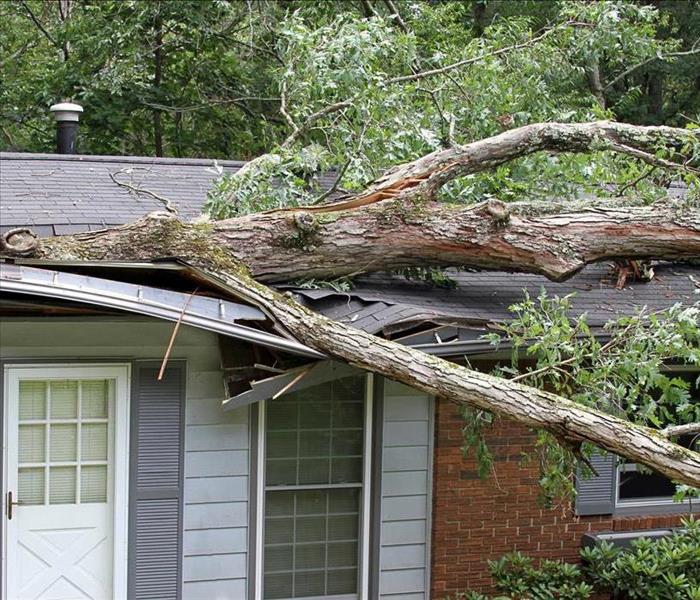 Roof damaged in Weedville, AZ
Roof damaged in Weedville, AZ
Roof Mitigation
If a storm compromises your roof in Weedville, AZ, you will need to protect it to reduce further roof damage. This process is called roof mitigation. You do not have to wait for an insurance adjuster to inspect your property before you begin mitigation. It is best to cover the damage right away to prevent any further harm to your home and its contents.
Residential storm damage restoration professionals can perform roof mitigation. The process takes a few steps.
Documenting the Damage
As soon as it is possible to safely do so, take detailed pictures and video of damaged areas. Restoration technicians can assist you with the process. Share the documentation with your insurance company so they will be able to assign an accurate dollar amount to the roof damage. You will also need records of work done prior to the insurance company's visit so you can add the expenses to your claim.
Covering Holes
Your roof might have sustained damage from several sources during the storm, including:
- Falling trees or limbs
- Wind damage
- Large hail
Technicians may be able to make some repairs right away. If the damage is more severe, restoration technicians will cover holes in the roof with tarps, boards and hardware. Covering any open places will help secure your home and prevent more rain or moisture from entering, causing further damage.
Creating a Restoration Plan
Once your roof is secured, storm restoration experts can prepare a plan for permanent repairs. They might also work with you on a plan to prevent future storm or wind damage. Whatever method is needed to fix your roof, storm remediation technicians will walk through the process with you to ensure your work is complete.
Dealing with roof damage in Weedville, AZ, after a storm can feel overwhelming to any homeowner. Your insurance company and a professional storm damage remediation company are available to help you with home repairs.
Tips for Selecting and Maintaining a Business Generator
8/31/2020 (Permalink)
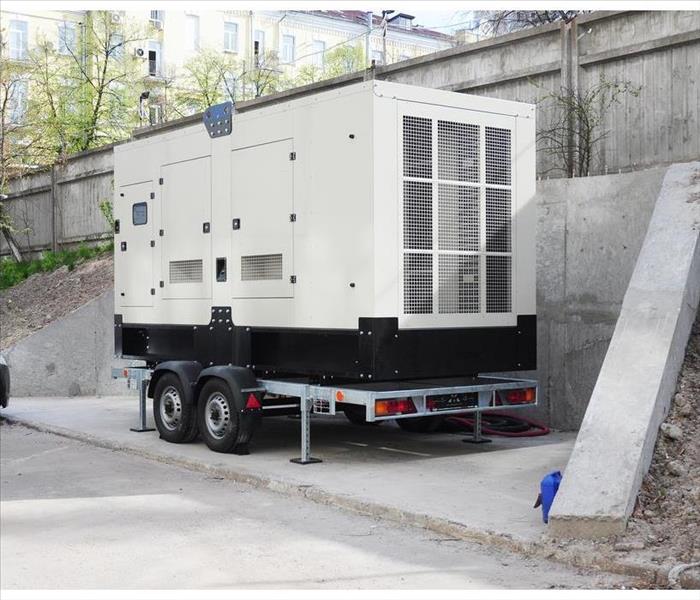 Consider installing a generator to remain functioning if you lose power
Consider installing a generator to remain functioning if you lose power
Selecting and Maintaining a Business Generator
If your business in Peoria, AZ, is in a flood zone, you might consider installing a generator to remain functioning if you lose power. If your electricity goes out, this unit will turn on automatically, allowing you to:
Keep the lights on
Service your clients
Access your computer records
Communicate with employees and clients
When choosing a unit to supply power for your business, consider the following.
Size
If you want your power to be uninterrupted, a stationary, standby generator is the best option. It is connected to the exterior power line and automatically turns on when it detects a pause in electricity flow. This option can last for years because it can provide up to 30,000 hours of power. You will need a permit to install a stationary unit for your business.
As an alternative, you can opt for something smaller and portable. This option is not attached to power lines and must be filled with fuel manually. It works best for small businesses or spaces with low power needs; filling them is impractical for supplying power to large areas.
Fuel Type
Once you've chosen the best unit for your needs, you need to decide what type of fuel you will use. The choices include gasoline, diesel, propane, and natural gas. Factors that may affect your decision include availability, price, efficiency, and storage requirements.
Maintenance
Whether you choose a stationary or a portable unit, it won't matter if it doesn't work during a power outage. Regular inspections and maintenance are critical to prevent or repair generator problems or damage. For stationary standby units, it is necessary to inspect parts for wear, change filters and run load tests along with other inspections required by the Environmental Protection Agency (EPA).
A severe storm can cause your Peoria, AZ business to suffer from loss of power unless you use a generator. If you also experience flooding and mold development, a disaster cleanup company can step in to help.
Basics of Flood Cuts and Post-Flood Repairs
8/12/2020 (Permalink)
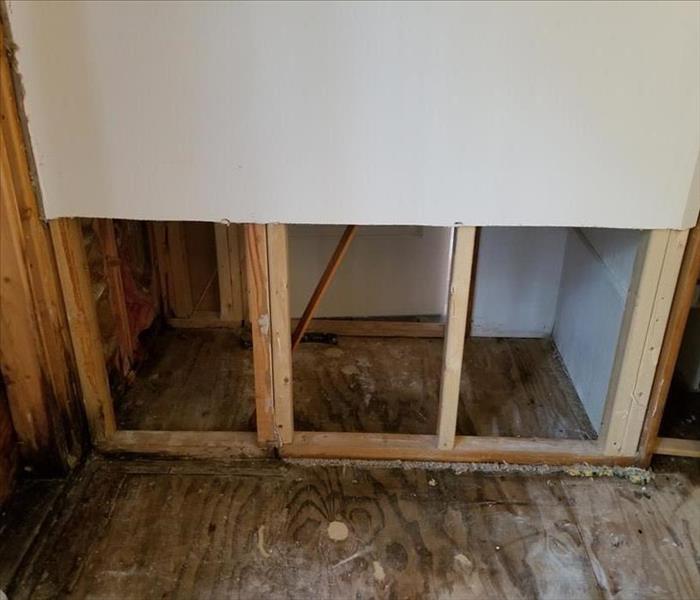 Flood cuts involve removing walls approximately 12 inches above the flood damage level
Flood cuts involve removing walls approximately 12 inches above the flood damage level
In the event you experience flooding in your home, your walls may need to be partially removed. This procedure, known as a flood cut, is often required to properly eliminate harmful contamination.
Flood Cut Basics
Flood cuts involve removing walls approximately 12 inches above the flood damage level. Perform a flood cut under the following circumstances:
- Your walls become soaked with contaminated water.
- You discover mold behind walls.
- You experience wet insulation, which is impossible to dry.
If your home in West Glenn Estates, AZ, suffers one of these conditions, a flood cut is needed. Employ an experienced technician to determine the extent of the mandatory tear out caused by the flooding. Flood cuts are messy, so use a tarp to catch debris. Remember that protective gloves and respiratory equipment should always be used to assure safety.
In cases where walls are not insulated, you may avoid a flood cut altogether. Try airing the wall by drilling holes behind the baseboard and letting air hoses dry it from behind. In the event this fails, a flood cut will likely be the optimal path forward.
Post-Flood Cut Restoration
Once your flood cut is completed, the polluted drywall must be bagged and thrown away. In addition to any walls needing restoration, your flooring, cabinets or drywall may also need fixes. When those overhauls are completed, have the entire area sanitized by using an EPA-registered cleaning agent. For best results, hire an expert flood restoration service to handle these taxing assignments.
Remember to file your insurance claim promptly. Without adequate funds, tackling a complicated wall removal project becomes nearly impossible. If you need insurance, be sure to purchase coverage before your walls need urgent reconstruction.
Because of the risk posed by fungi and other pathogens, flooding commonly necessitates tearing out walls. Instead of tacking this on your own, choose an experienced professional who can swiftly and affordably get the job done.
What Is the Purpose of a Flood Cut?
4/29/2020 (Permalink)
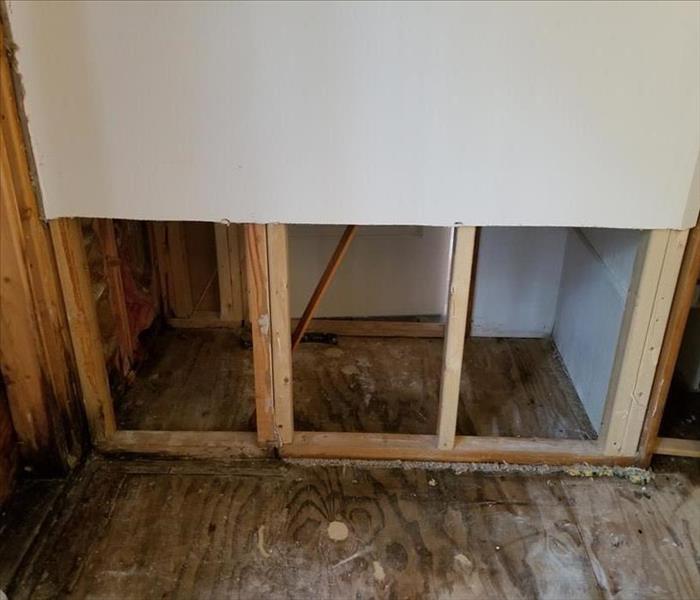 Storm damage restoration experts can recommend whether a flood cut is necessary at a residence in Peoria, AZ
Storm damage restoration experts can recommend whether a flood cut is necessary at a residence in Peoria, AZ
Learn More About the Role of Flood Cuts
Restoration professionals use flood cuts to remove contaminated building materials and promote drying. Flood cuts are made 12 inches above the flood line. In the event that two feet of contaminated water was left standing after flooding at a residence in Peoria, AZ, a flood cut would be made at a height of three feet. Learn more about the role of flood cuts in damage cleanup and restoration.
Determining Moisture Levels
A flood cut makes it easier to tear out drywall and insulation saturated with flood water. There are several reasons to remove contaminated porous building materials:
- Difficulty of drying
- Difficulty of disinfection
- Recontamination risk
Drywall and insulation are difficult to clean and should not be retained after flooding. A flood cut makes it possible to determine the extent of damage before removing and replacing damaged building materials.
Tearing Out Drywall
Once the height of a flood cut has been determined based on the height of standing water, damage restoration professionals will make a cut and remove damaged drywall and insulation. A cut and tear out should be performed prior to cleaning and disinfection to avoid reintroducing contamination.
Promoting Faster Drying
One of the major benefits of a flood cut is that removing saturated drywall and insulation makes it easier to dry out structural components that do not require replacement. Gaining access to the interior of a wall cavity is helpful for reducing the risk of hidden mold growth. Insulation and drywall should not be reinstalled until the structure is completely dry.
Storm damage restoration experts can recommend whether a flood cut is necessary at a residence in Peoria, AZ. These trained professionals can make a cut at the right height to clear out contaminated building materials. A flood cut can reduce the risk of secondary or structural damage after flooding introduces contaminated water into the interior of a home.
5 Storm Preparation Areas for Your Company
4/9/2020 (Permalink)
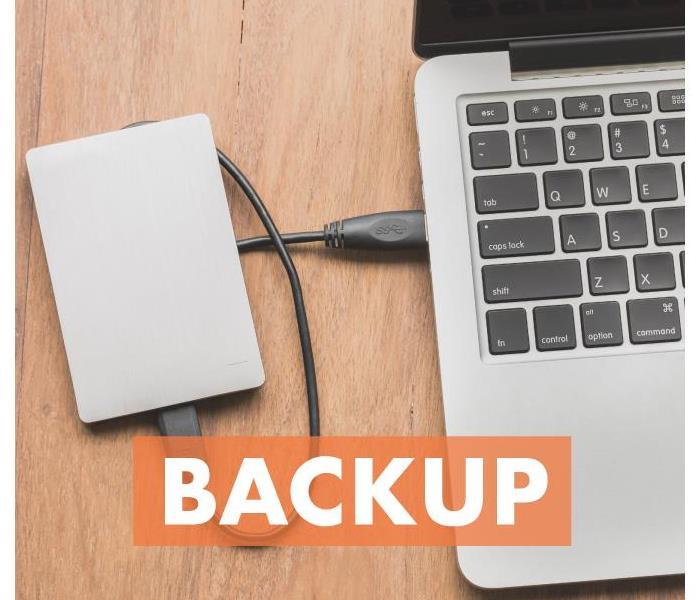 Make sure to back up all data before a storm
Make sure to back up all data before a storm
5 Storm Preparation Areas for Your Company
Even the most idyllic places on Earth still endure storms now and then and can face the dangers of floodwater. it is impossible to protect your company with 100 percent certainty, but actions taken today can strengthen your company's storm defenses. Something as simple as choosing a professional storm remediation team can go a long way toward making a complete recovery after a flooded building in Glendale, AZ. Consider shoring up these areas of your business to withstand a natural disaster.
1. Computer Networks - Flood water can do a number on your computer system. Make sure to back up all data before a storm and consider off-site solutions such as Cloud storage. Move sensitive systems to higher ground and reinforce protections where possible.
2. The Roof - A weak roof will more than likely let you down when torrential rains come. Water damage is expensive and can destroy everything from the structural integrity of your building to valuable paintings and prized possessions. A strong roof stands a better chance of holding up to high winds and severe weather.
3. The Landscaping - Smart landscaping decisions can play an important role in protecting your building. Sloping contours that divert water away from foundations have the ability to reduce the water load that walls must withstand. All storm drains should be cleared and should function as intended.
4. The Building - A building that is well maintained can help keep water away from the interior of your company. Storm-proof windows, sturdy siding, and secure doors protect employees, inventory and fragile computer systems. A strong building increases peace of mind and reduces the amount of damage a storm can inflict.
5. Your Employees - Make sure employees understand the role they play in storm safety. This includes going to designated safe areas, watching out for at-risk workers and avoiding coming into contact with compromised electrical systems and contaminated flood water.
Steps for Easy Sump Pump Maintenance
11/16/2019 (Permalink)
Few homeowners think much about their sump pump before a storm. But that’s exactly when this handy piece of equipment should be top of mind. Neglecting pump maintenance can result in a pump that doesn’t work when needed. The good news is that there are just a few key steps to ensure your West Glenn Estates, AZ, home’s pump is always ready for action.
How Your Sump Pump Works
Your pump is a critical tool in the war against home flooding. Common among homes in low-lying areas, these pumps work by:
- Collecting water in a special pit
- Pumping water out of the pit
- Redirecting water away from your home’s basement and crawlspaces
Keeping your pump in good working order isn’t hard or expensive. Maintenance comes down to periodic maintenance - quarterly and annually.
Quarterly Maintenance
You’ll want to check on your pump every three to four months. Start with cleaning the inlet screen and checking the power cord. If you see fraying or other signs of wear, replace it. Fill a bucket with water and pour it into the pump until the float raises. Ensure that the pump comes on and you’ve finished your quarterly check.
Annual Maintenance
Once a year, you’ll need to take a few extra steps. Clean out the sump for starters, removing and checking the pump for signs of damage. This includes looking at the bearings for signs they need lubrication. Check the power source again for proper connection and finish up by once again pouring water into the pump to ensure it responds the way it should during a flood.
A sump pump can seem unimportant until a flooding emergency. Make sure your pump will be ready to keep your home dry when an emergency arrives. Use these tips to ensure your pump is in working order and contact your local water remediation company for further tips on handling water emergencies.
Tips for Preparing Your Business for a Hurricane
10/30/2019 (Permalink)
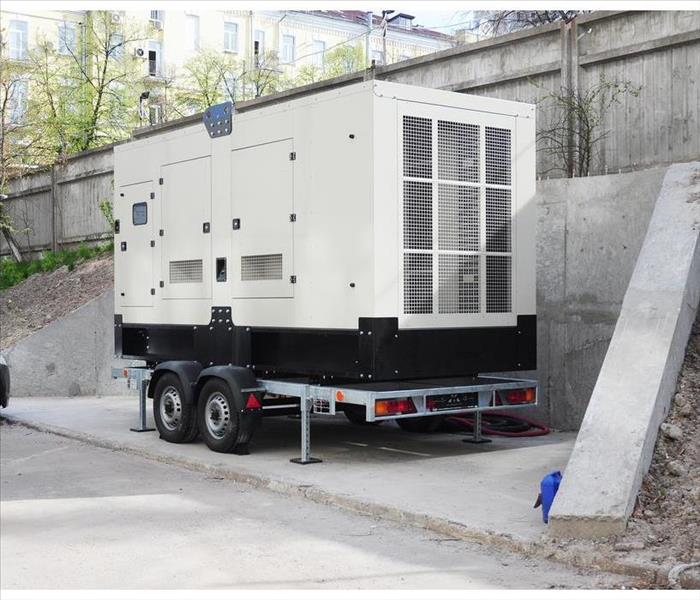 Backup generators can provide emergency power if it's safe enough to stay through the storm
Backup generators can provide emergency power if it's safe enough to stay through the storm
If you live in an area that experiences hurricanes, such as Grand Manor, AZ, you already know how devastating they can be. Because of this, you likely realize the importance of preparation when one of these superstorms is headed your way. The flood water can be the main threat along with high winds. It can take months to repair a flooded building, and restorations can cost a lot of money. If you are prepared, you may be able to minimize long-term damage to your business.
Protect Your Business
There are a few things that may help minimize the destruction your organization incurs:
- Boarding up windows can often prevent breakage from flying debris due to high winds.
Sandbags can help deflect water to another location.
- Backup generators can provide emergency power if it's safe enough to stay through the storm.
Devise a Plan
Part of being prepared is having a plan. It's important to have this strategy written out in advance since it's less likely you will forget something when you aren't as stressed. Be sure to practice your emergency plan so that you can work out any kinks that may happen.
Back Up Your Data
Since electronics typically don't fare well in flood water, it is imperative that you back up all of your data regularly. Set a reminder so that you don't forget to do it on a scheduled basis. Have all of your employees back up their data as well. That way, if you experience water damage and lose your computers, it will be much easier to get up and running again.
Work From Home
If at all possible, set things up so you can work from home or another office location during the time your building is being repaired. This can keep your operations functioning smoothly, which will help prevent a substantial financial loss.
No one wants to experience flood water or wind damage from a hurricane, but these tips can help you prepare just in case. After a hurricane, let your cleanup and restoration services get your business back to normal.
Things You Should Keep in Mind After a Flood
9/9/2019 (Permalink)
 It is in your best interest to wear protective clothing and gloves at all times when flood water is present
It is in your best interest to wear protective clothing and gloves at all times when flood water is present
Here Are Some Of The Main Things You Should Keep In Mind After Flood Water
If a flood takes place, there are many precautions you should take to make sure you are safe from danger. Here are some of the main things you should keep in mind after flood water has taken over your home.
1. Stay Away from the Water
Standing water may seem safe after a flood, but there is a big chance it is electrically charged from underground or from power lines that have fallen during the storm. It is also dangerous to wade through the waters because you could be easily swept away and it can also carry things like sewage, debris, and chemicals that are dangerous and could lead to infections and diseases. If you are dealing with a flooded home, it is best to put your safety first and stay out of the water at all times.
2. Be Aware of Mold and Mildew
When water damage is present, it is likely mold and mildew will follow shortly after. This can lead to structural issues in your home and it can also be dangerous to breathe in mold. It is best to stay away from any area you think may have mold growing until you can have a professional come out and deal with the area.
Wear Protective Clothing
It is in your best interest to wear protective clothing and gloves at all times when flood water is present. This type of water is not safe and can be filled with debris and chemicals that you should protect your body from. There is also a chance you could come in contact with an animal that could lead to injury and even disease. If you are cleaning up after a flood, be sure to wear a protective mask as well to keep your face safe and protected.
These are just a few of the most important safety tips you should keep in mind if you are surrounded by flood water in West Glenn Estates, AZ. It is a good idea to have a professional come out to your home to perform a water damage assessment and see how serious your situation is before trying to repair and cleanup on your own.
What Is the Expected Lifespan of a Commercial Generator?
8/26/2019 (Permalink)
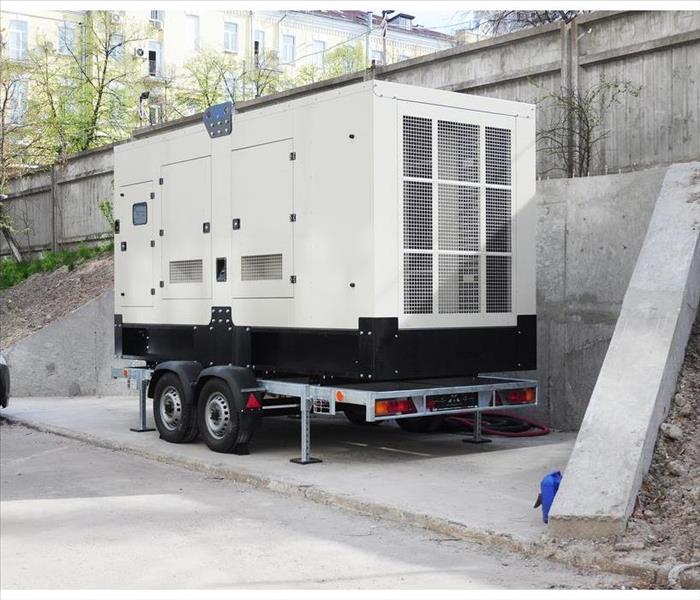 A commercial generator can help provide backup power to your building while you wait for emergency services to arrive
A commercial generator can help provide backup power to your building while you wait for emergency services to arrive
If an emergency ever causes the power to go out in your commercial building in Grand Manor, AZ, a generator can help provide backup power to your building while you wait for emergency services or a restoration specialist to arrive. Whether you are already own one of these useful machines or are considering buying one for your business, you will need to know what you need to do to keep it ready and running for when an emergency strikes.
Expected Lifespan
While the actual lifespan of your machine will depend on how the type of device, the amount it is used, and how well it is maintained, the expected lifespan for the average standby generator is anywhere from 10,000 to 30,000 hours. These machines are typically not used very often throughout a given year and are only ran during weekly exercises and power outages. So they often last 20 to 30 years before needing to be replaced.
Common Problems
There are several generator problems that can occur that can potentially reduce the lifespan of the machine or leave your business without power if an outage does occur. Here are a few to look out for:
- Bad belts that might be too dry or cracking
- Low coolant or oil which can cause other issues such as overheating, broken pistons, or engine failure
- Low fuel or bad fuel
- Burnt electrical components, coils, or other parts
- A dead battery or bad connection
- Block heater hose failure
Preventative Maintenance
The best way to prevent common issues and to help your machine last for its expected lifespan is to perform regular preventative maintenance. It helps to create a schedule that includes weekly tasks, monthly visual checks, the servicing of critical systems, and semi-annual inspections.
You never know when an emergency might happen, which is why it is important to make sure your building’s generator is ready to go. With the correct maintenance plan in place, your machine can give you peace of mind for many years to come.
How To Mitigate Storm Damage to Your Home
7/10/2019 (Permalink)
 Roof damage due to high winds in a Grand Manor, AZ home
Roof damage due to high winds in a Grand Manor, AZ home
Ways you Can Mitigate Roof Damage
If your home in Grand Manor, AZ, has been targeted by water or high winds, it’s important to take the appropriate measures to mitigate as much damage as possible until restoration services arrive. Because the roof and windows of your home are particularly vulnerable to weather elements, working to alleviate damage to these areas should be a priority. Below are some of the ways you can mitigate roof damage and other types of harm caused by a storm.
Patch Your Roof With Tarp
Using tarp to patch up your roof can effectively prevent any additional damage to it. To properly apply tarp, do the following:
- Lay out tarp on roof
- Cover ridge line completely with tarp to block out water
- Use nails or screws to secure tarp onto roof boards
Correctly placing tarp on your roof helps you avoid further water and wind damage while keeping your roof secure. Tarp can also be used to cover any leaks or holes on your roof that were caused by the storm.
Remove Debris
If fallen tree limbs or other types of debris have caused roof damage, it’s crucial to have them removed as soon as possible. Call a tree removal company to safely discard any tree branches or other objects that have landed on your roof and harmed it as a result. Having a professional remove debris can ensure that nothing poses an additional risk to your home.
Cover Up Holes
Any holes that have appeared in your windows after the storm should be covered up right away. You can use plastic to seal up any holes or cracks in your windows to prevent them from additional leaks or damage. Keeping everything in your home covered up and protected increases your sense of security as a homeowner.
Doing what you can to mitigate window and roof damage helps improve the condition of your home after a storm hits. Be sure to call storm damage restoration services to ensure that your home recovers fully from the damage.
4 Ways You Can Help Protect Your Business Against a Disaster
5/11/2019 (Permalink)
 Your employees need to know you have a plan of action in place for their safety
Your employees need to know you have a plan of action in place for their safety
4 Tips for Disaster Preparedness
As a business owner or manager in Glendale, AZ, you know that one of the best ways to prevent a disaster that could strike your company and do catastrophic damage is to be prepared by taking proactive measures. Here are four tips for disaster preparedness that you can take to make sure you are ready for any emergency that comes your way.
1. Insurance
Insurance can be one of the most important parts of disaster recovery. Whether it is from the government or an area agent, purchasing a disaster umbrella policy can mean the difference between getting back to business quickly and closing your doors forever.
2. Threats
Preparing your business for a possible disaster from inside threats can alleviate emergency situations. Knowing how to turn off natural gas outlets, where the water main is, and having utility numbers stored in your phone can allow quick action if the need arises.
3. Action
It is not enough for management to be part of disaster preparedness; your employees need to know what to do as well. Whether it is a sudden storm that causes flood waters, a blackout situation in freezing temperatures, or a tornado warning that comes out of nowhere, your employees need to know you have a plan of action in place for their safety. It is often a good idea to have classes and drills with your employees to help them understand what steps to take.
4. Preparedness
Using clouds services for important documents, moving electronics to a second floor, and having an emergency restoration budget to get your business open quickly are different types of business preparedness plans. Having a working relationship with a disaster restoration company can also speed the reopening of your business.
You can help protect your company from a disaster by practicing disaster preparedness. If a catastrophe strikes, you can be ready because you will know just what to do when you follow the above steps.
Do I Really Need a Flood Cut to Fix My Wall?
4/25/2019 (Permalink)
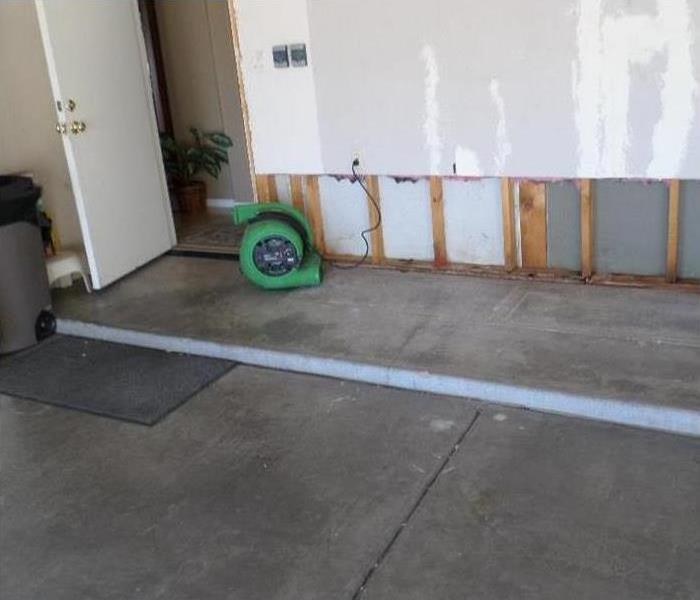 Drywall removal in a Peoria,AZ garage
Drywall removal in a Peoria,AZ garage
When working with a contractor to restore your property after flooding, you often hear different terms and procedures that don’t make a lot of sense. One of the most common is a flood cut. What does it mean? Should my cleanup team be offering one? Knowing the answers to these and other questions surrounding this type of tear out procedure can help you choose the right flood restoration professionals for your Peoria, AZ, property.
What is a Flood Cut?
The term simply means a contractor will cut water-damaged drywall from walls or other areas in your property. The process lets your cleanup partner locate and address any extra moisture behind the walls. Such moisture can lead to:
How It’s Done
First, professionals will examine your walls for signs of water damage such as warping or even early mold. Next, they will cut into the wall, roughly 12-18 inches from where the flood damage happened, and remove a piece of the wall. Next, steps will be taken to dry or replace insulation, depending on the level of damage, before the wall is repaired.
When is it needed?
A flood cut is not required if the wall is damaged by clean water. Unfortunately, flooding is typically associated with contamination by human waste or pathogens. In those cases, leaving wet insulation can result in not only structural damage, but actual illness. Flood cutting can also be avoided if there isn’t insulation behind a wall, in which case less invasive methods may be used.
Cutting into your drywall may seem like a dramatic response for a little flooding. But doing it now can save you a lot of extra expense when you’re facing mold or worse down the road. Consult with a skilled flood mitigation expert to learn whether a flood cut, or other process is key to getting your property back to normal.
Does Commercial Insurance Cover Storms?
2/13/2019 (Permalink)
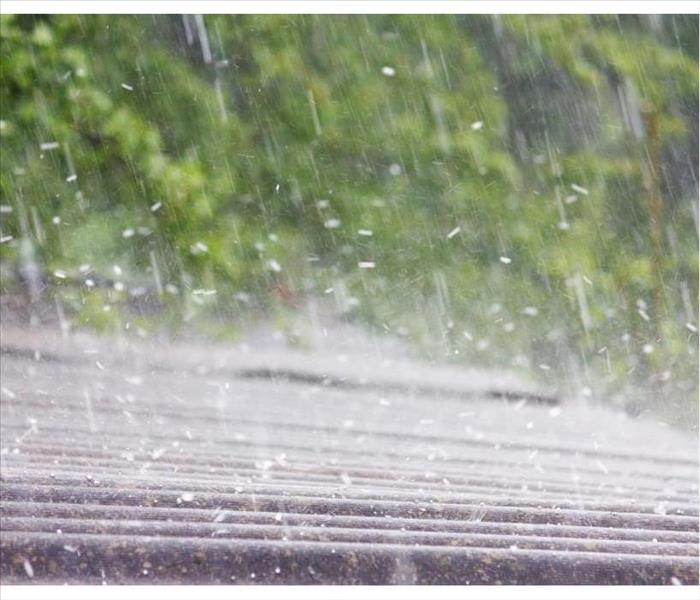 Hail on roof in Grand Manor, AZ
Hail on roof in Grand Manor, AZ
Commercial property insurance policies cover many types of storm damage. Owners of buildings in locations prone to hurricanes or flooding may want to consider an additional storm insurance policy or rider on an existing policy. Find out more about covered perils and which exclusions or limits to look out for in a policy.
Hail and Wind Damage
Most general commercial property policies cover damage caused by hail and wind. These conditions may result in several forms of damage to roofing materials:
- Bruises
- Cracks
- Dents
- Punctures
Be sure to document damage before tarping over or taking other mitigation measures. Insurers are more likely to cover a claim if the owner can prove a roof was in good condition prior to a storm.
Leaks and Flooding
If a roof leaks due to damage sustained during a storm, commercial property insurance should cover the damage as long as the roof was previously in good condition. Flooding caused by the following conditions is not covered by most commercial property policies:
- Heavy rain
- Rising bodies of water
- Sewer backups
Supplementary flood or storm insurance policies or endorsements will be necessary to cover damage caused by accumulating rain. Heavy rain can also cause municipal sewer mains to back up into buildings. Additional sewer coverage may also be necessary.
Hurricanes and Tornadoes
Hurricane damage is cut out of many commercial property policies or may be subject to special insurance coverage requirements such as percentage deductibles based on property value. Property owners may want to seek additional coverage. Most policies cover damage caused by tornadoes, but policyholders should purchase a sufficient amount of coverage to compensate for a total loss.
Many types of storm damage should be covered by a commercial property policy for a building in Grand Manor, AZ. Flooding, hurricanes and sewer backups may require additional storm insurance to offset the costs of commercial mitigation and restoration.
Put Your Home in the Hands of Professionals
2/6/2019 (Permalink)
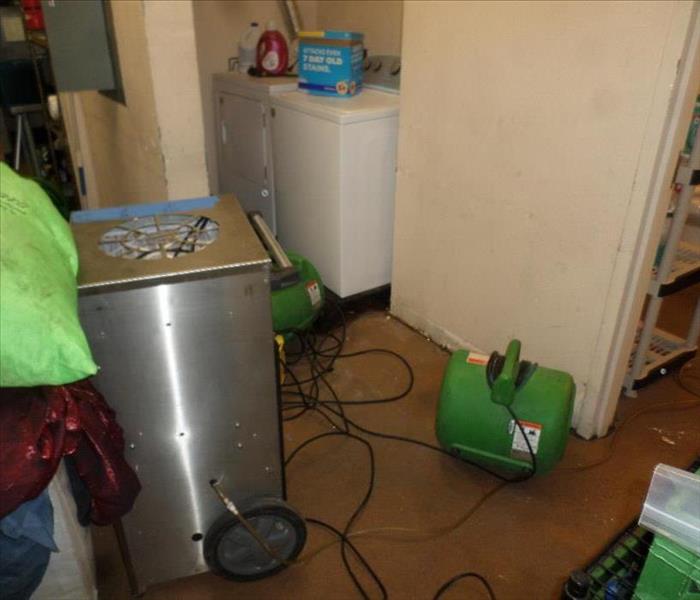 Storm Damage in a Glendale Home
Storm Damage in a Glendale Home
Professional Storm Remediation Services
You never expected that you would need storm remediation. Storm damage happened to someone else, not you. Ice damage, hail damage, and wind damage always passed you by. You managed to escape winter storms and hurricane damage in the past. This time you weren't lucky. The storm damage struck and now you are left with the wreckage. River flooding and flooding can cause ground water or flood water to invade, filling your home with water at alarming levels. You're bound to need water restoration and roof repair services for roof damage caused by wind damage or hail damage. Don't try to handle any type of storm renovation services on your own. When you require home restoration and storm restoration services, you have professionals who are ready to handle any challenges coming your way.
Visit http://www.SERVPROpeoriawestglendale.com for more information on storm damage.
Put Yourself in Hands You Can Trust
2/6/2019 (Permalink)
It is too overwhelming to handle storm restoration services on your own and you should not even attempt it. If you have been affected by any type of flooding or river flooding, you will have ground water or flood water. You will require a flood pump as part of water restoration services.
Flooding is one of the most serious types of damage, whether it is brought on by river flooding. To eliminate ground water or flood water, your storm restoration team will take advantage of a flood pump.
A powerful flood pump can do wonders when you have a build up of water in your home. If you need water restoration as part of your home restoration plan, expect a flood pump to do its job for storm remediation.
Once the flood pump has removed the water, your team of professionals can pinpoint other problems caused by storm damage. Wind damage and hail damage are typical causes of roof damage. A roof will have tarps placed on it to keep it from leaking anymore into the house.
Once flood water or ground water has been eliminated and any type of roof leak has been isolated, the repair phase can begin.
Flooded Homes Have an Unpleasant Odor
9/14/2018 (Permalink)
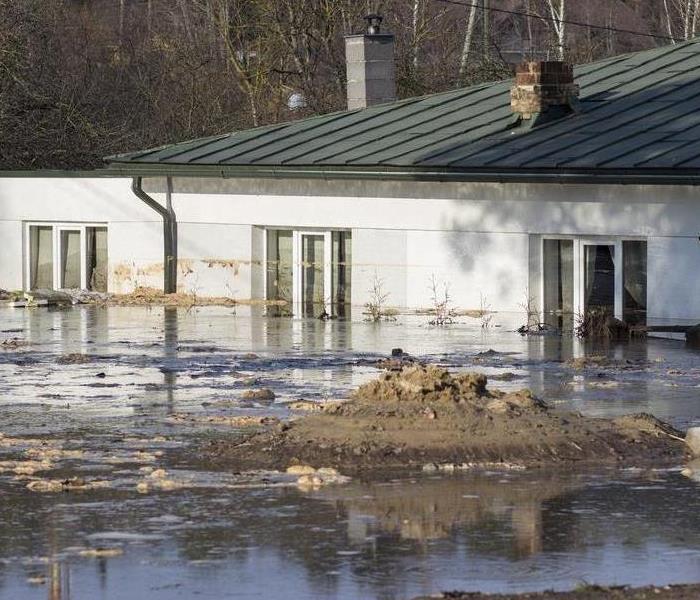 Floods are dangerous! When the water recedes be sure to call the professionals for help!
Floods are dangerous! When the water recedes be sure to call the professionals for help!
Although the smell of your flooded home in Peoria, Arizona, may be repulsive, that is not your biggest problem. Your biggest problem has to do with the source of the odor. Frequently, that is mold growth.
No two flooded homes have the same issues, but they all have things in common
Floodwater Sets the Stage for a Massive Mold Problem
From a property damage perspective, this may be your biggest threat. If the odor you smell has a musty component to it, you may already be well on your way to a mold problem. The only way to remove musty odor is to quickly dry out your home and remove any mold that has started to grow.
Sewage Backup Is a Serious Health Hazard
Sometimes, flood water will cause sewage to back up from the sewer system into your home. The pungent odor it brings with it is a reminder of the bacteria and other dangerous organisms that the sewage contains. It is a risk to humans and animals and can result in significant property damage and sewage system loss. Left untreated, sewage can also be the source of mold growth. This odor will not disappear until the sewage is removed and the affected areas are cleaned, disinfected and deodorized.
Floods Bring in Other Sources of Odor
When the water recedes, you can expect to find that the flood left just about everything imaginable behind including topsoil, garbage, and other debris. There may also be traces of gas, oil and other petroleum residues. In small quantities, none of this poses a significant hazard. They can be easily cleaned up and deodorized.
The Foul Odors Are Gone, and a Fresh Smell Has Returned
The key to flood cleanup and the prevention of mold growth is knowing how to deal with the several different aspects of flood damage. Consider bringing in a team of local flood remediation specialists with the experience and equipment to do the job right. Your home will thank you for it.
Protect Your Windows With Storm Shutters
7/23/2018 (Permalink)
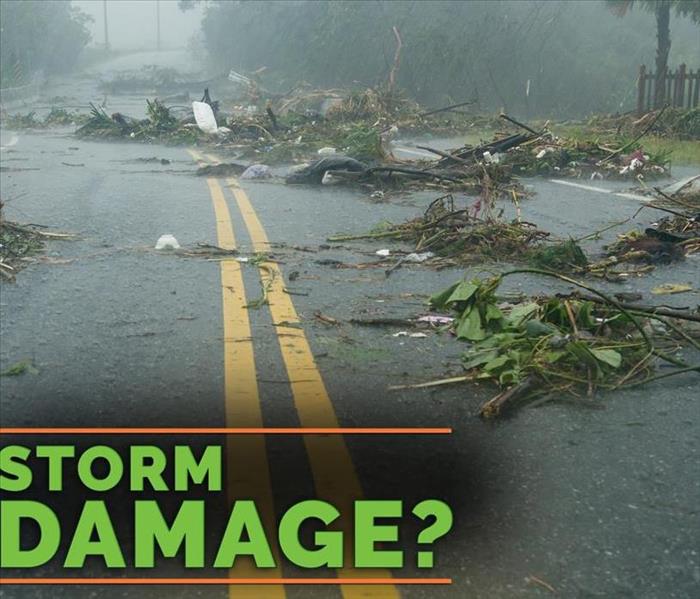 When your protection is put into place, you will feel better prepared for future storms and high winds.
When your protection is put into place, you will feel better prepared for future storms and high winds.
In Peoria, AZ, high winds can be a threat to your home. One of the most dangerous risks when storms hit and strong gusts begin are objects being thrown around and crashing through your windows. If this happens, you may need to call a restoration service. However, one line of defense is to invest in storm shutters. These cover your windows with strong materials, stopping objects from breaking the glass. The most common types are listed below from most to least costly.
1. Colonial
Keeping in mind visual appeal, Colonial style is a permanent addition to the windows while also looking decorative. They are priced per window from $200 to $500.
2. Rolling Shutters
This style is called “rolling” due to the fact they unroll across the windows from a box that has been permanently fixed above the window. These tend to be the most sturdy and protective from high winds and are priced per square foot from $20 to $30.
3. Bahama
With the most tropical-sounding name, the Bahama style is best for houses in hot areas with lots of sunlight, as they can work as awnings but then be lowered over the windows to protect them in a storm. These can be priced per square foot at $15 to $20 or per window at $200 to $1,000 each.
4. Accordion
Crimped in the way an accordion is, these shutters are unfolded across the window manually and then locked into place. These are generally sold for $15 to $25 per square foot.
5. Storm Panel
These panels are not permanent and are, instead, stored away until needed. When they are, they are bolted around the window to cover the glass. They are sold from $7 to $15 each.
6. Plywood
At the low price of under $1 per square foot, plywood works well if needed quickly. They may not look good and can be hard to install, but they are more affordable.
Once you’ve made a decision on which storm shutters you would like, you can call an installation service to get exact pricing. Then, when your protection is put into place, you will feel better prepared for future storms and high winds. For more information, visit http://www.SERVPROpeoriawestglendale.com/.
Ways to Maintain the Roof of your Commercial Property
6/14/2018 (Permalink)
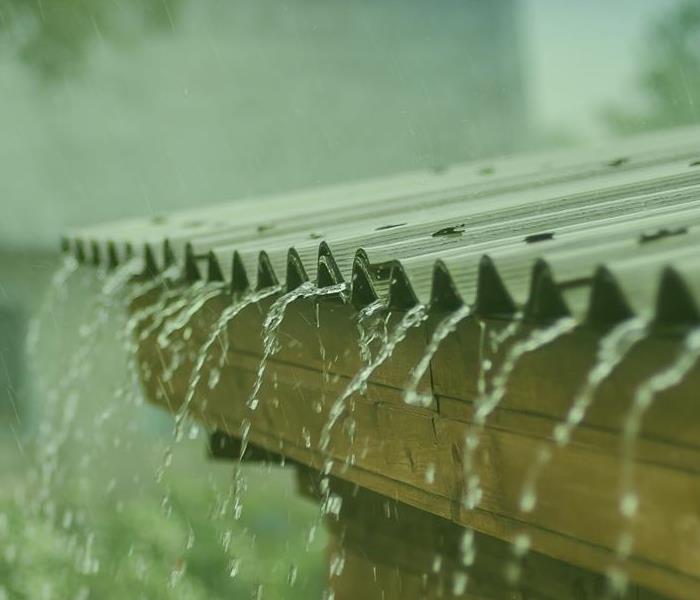 The best solution to a roof leak is preventing it from happening in the first place.
The best solution to a roof leak is preventing it from happening in the first place.
The roof of your commercial property in Peoria, AZ, is one of the most important parts of its external structure. It protects the interior from various elements of the weather and helps to provide a buffer against extreme outside temperatures. When it gets damaged, however, you could experience a roof leak or any number of negative outcomes. Regular roof maintenance is necessary for keeping it in top shape.
Signs of Damage
One aspect of maintenance is simply a regular roof inspection. Storms can cause hail and wind damage, which can lead to other types of damage. There are several items to check for when inspecting your roof:
• Water stains on the ceiling, indicating a leak
• Musty smell or visual evidence of mold growth
• Ponding water on the roof that could cause deterioration or roof leak
• Bubbles on the roof cover where moisture or gasses have gotten trapped
• Gaps in the flashing from high winds
Owner Maintenance
The best thing you can do to keep your roof in good shape is to make sure that the gutters and storm drains stay clean. Clear out the debris on a regular basis so that water can drain properly. This keeps it from pooling on the roof and causing the structure to weaken and deteriorate.
Professional Maintenance
It is a good idea to have professionals inspect your property on a regular basis. They may catch problems that you don’t see. If you do see signs of leakage, call water remediation specialists immediately. They can survey the damage and resolve the issue before it gets out of hand. All weak spots or warped areas should be replaced by a roofing professional so that you can prevent more leaks from happening.
The best solution to a roof leak is preventing it from happening in the first place. If you perform regular maintenance on your commercial property, your roof may enjoy a long life. For more information, visit http://www.SERVPROpeoriawestglendale.com/.
Quick Guide: Storm Damage Cleaning vs. Other Flood Cleaning
4/18/2018 (Permalink)
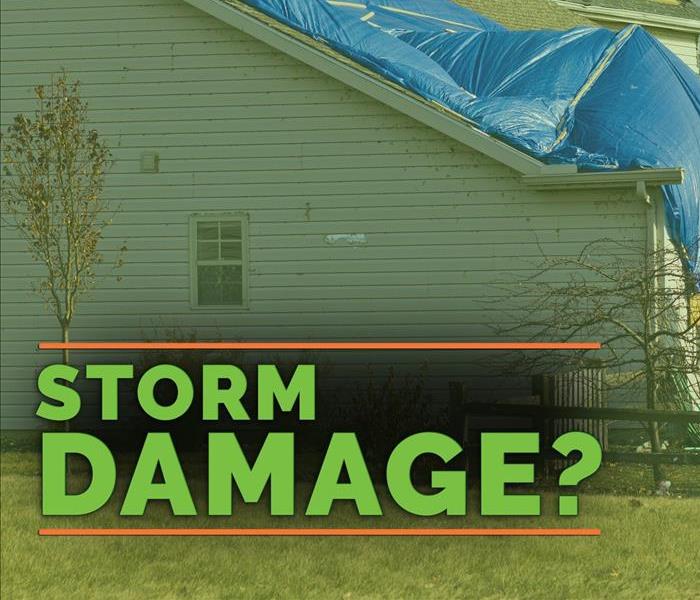 Give SERVPRO a call if you experience storm damage. We have technicians available 25/7.
Give SERVPRO a call if you experience storm damage. We have technicians available 25/7.
When storms accompanied by heavy rain pass through Peoria, AZ your home may be at risk for flooding. If damage does occur, working with a residential storm damage expert can make the cleanup much simpler for you. However, you may still wonder how cleaning up after a storm is different from cleaning up after a pipe burst or another source of flood water.
Storm Damage
Storm damage can include more than flood damage. You may also have to deal with disrepair caused by wind, hail and other weather elements. Because there are so many potential factors, cleaning up after a storm may require certain steps, such as the following:
• Making repairs to roofing and siding
• Using a pump to remove standing water from a house
• Drying out furniture and other possessions
• Disinfecting areas affected by flooding of potentially dirty water
• Repairing damage caused by water
• Getting rid of mold
Depending on the severity of a storm, some homeowners may even have to make structural fixes to their homes.
Other Flood Damage
Your home can have standing water for other reasons besides a big storm. Burst pipes, backed up appliances and clogged toilets could cause flood damage in your home. When this type of water source leads to a flood, the repair process is typically a little different.
First, you know the exact source of the water. This allows you to determine whether the water is clean or dirty. If you know the water is not contaminated, you may not have to disinfect your belongings after drying them out. Second, you have to find the source of the water deluge and fix the problem. If you simply dry out your house without fixing the source of the flood, you may have to deal with more water damage in the future.
The way your remediation team handles flooding will depend on the source of the water. Clean and dirty water have to be taken care of differently to ensure your home stays in top shape. Visit http://www.SERVPROpeoriawestglendale.com for more information on storm damage.
Flash Flooding in Peoria, AZ
1/10/2018 (Permalink)
Flash Flood Damages Homes
If you experience flash flooding and water rises above the main level of your home, you need to be aware of the quality of the water soaking through your drywall and damaging your floors.
This water is called a “Cat 3” or Category 3, the worst quality of water measured. Cat 3 water can contain chemicals, carcinogens, sewage, and dead animals. It is important you do not come in direct contact to Cat 3 water.
Professional Restoration Services
As a professional restoration company, SERVPRO of Peoria/West Glendale, is experienced at extracting the water and removing all materials affected by this type of water. We also use EPA registered antimicrobial solutions to kill bacteria and make the structure safe for human habitation. Our technicians are trained to take care of your possessions and we will be with you every step of the way.
Give us a call at 623-376-9779.
Faster and Exceptional Restoration
1/10/2018 (Permalink)
Hiring a team of qualified water damage professionals is equivalent to efficiency. It will be in just a matter of time for ones water cleanup and mitigation process to be complete. As opposed to self-restoration, they have extensive experience as a restoration company. Repairing of small failures such as supply line break and pipe break is no big deal. In addition, they are able to clear the task in no time as they normally work in multiple. This usually does not matter on what size the flooded home is. Besides that, the restoration company has efficient tools that are suitable for the whole process of water cleanup and drying hence a quality restoration result.
Visit http://www.SERVPROpeoriawestglendale.com for more information on storm damage.
24 Hour Services During Storms
1/10/2018 (Permalink)
Availability of Emergency Services
A professional water damage/flood damage restoration company is capable of an around the clock services. It is not easy to find a company that will offer you great services at all time.
Emergencies are never planned and if you can find an institution that can stand with you at all times of emergencies, then you had better stick to its services. Professional Restoration Company is capable of such services in case of water in home or water in business at any given time.
The restoration company will be at your doorstep within no minute. It does not matter what time or day it is, or if the case involves minor services such as the supply line break or pipe break. If your water damage restoration company is good they will address your problems. For these reasons, it is advisable that whenever you experience water in home or water in business; consider the services of professional flood damage mitigation company.
Visit http://www.SERVPROpeoriawestglendale.com for more information on water damage.
Top Benefits of Hiring Professionals After a Flood
9/21/2017 (Permalink)
Top Benefits of Hiring Professionals After a Flood
In most cases after water damage in a flooded home, homeowners always wonder on what to do next. The moment is always traumatizing and one is always looking for an immediate and efficient restoration to the flood damage. At some point, one might think of doing it on his own but believe me, the whole process will be worse. A flooded home can be as a result of storm while in most cases, a pipe break or a supply line break. In any case, it is not recommended that you conduct restoration on your own. For quality services, it is best that one would consider consulting a professional restoration company.
The flood damage services they offer includes numerous procedures such as water cleanup, drying, reconstruction, and repairs to a flooded home among others. In addition, they fix pipe break and supply line break if at all they might be the cause of the flood. For these reasons, hiring the water damage professionals can be the only option. This is because, for one to avoid any further damages to your property, the mitigation process should be deployed as first as possible. Professional water damage restoration will always be the best way to your property protection.
Visit http://www.SERVPROpeoriawestglendale.com for more information on storm damage.



 24/7 Emergency Service
24/7 Emergency Service























